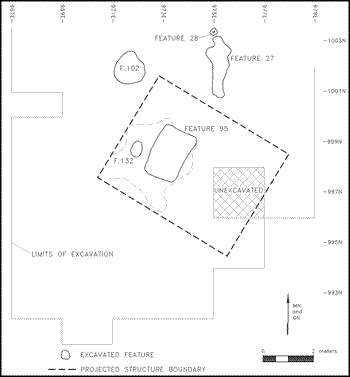Structure 3
 Structure 3 at Site 44JC969 is a rectangular building estimated to measure 15 x 20 feet. As with nearby Structure 1, no structural or enclosure-related posthole features were identified in direct association with Structure 3. Indeed, Structure 3 is less visible archaeologically than any of the other structures, so interpretations of its above-ground characteristics are limited. Though the feature assemblage directly associated with Structure 3 includes only one subfloor pit and a subfloor depression, the similarity of these features to those of the other structures suggests that all the structures represent the same general occupation. Thus, the estimated dimensions of Structure 3 are considered to be similar to the other structures, given an absence of archaeological evidence to the contrary.
Structure 3 at Site 44JC969 is a rectangular building estimated to measure 15 x 20 feet. As with nearby Structure 1, no structural or enclosure-related posthole features were identified in direct association with Structure 3. Indeed, Structure 3 is less visible archaeologically than any of the other structures, so interpretations of its above-ground characteristics are limited. Though the feature assemblage directly associated with Structure 3 includes only one subfloor pit and a subfloor depression, the similarity of these features to those of the other structures suggests that all the structures represent the same general occupation. Thus, the estimated dimensions of Structure 3 are considered to be similar to the other structures, given an absence of archaeological evidence to the contrary.
No evidence of a hearth or chimney base was identified for Structure 3, though a 6.6-x-6.6-foot (2-x-2-meter) area at the interpreted southeast end of the structure could not be excavated due to the presence of a large tree. Thus, it is quite possible that a hearth/chimney was located within the unexcavated locus. Such a layout would be consistent with those of the other two fully excavated structures at the site, reflecting the placement of hearths at the southeast ends of the dwellings.
Structure 3 may not have been occupied as long or used as intensively as the other structures on the site. Apparently, it contained only one shallow subfloor pit, filled with a relatively sterile primary deposit. The orientation of the subfloor pit is about 15 degrees different than that of the other subfloor pits on the site, suggesting that Structure 3 was not oriented on the same alignment as the other three structures, which in turn raises a possiblity that Structure 3 was not constructed at the same time as the other identified structures. Log or frame cabins built entirely above-ground largely replaced earthfast structures (with wooden supports sunk into the ground) as slave housing by the late eighteenth century, which may suggest that both Structures 1 and 3 were built later than Structure 2. Furthermore, the different alignments of Structures 1 and 3 coupled with the fact that pearlware ceramics occur most frequently in the topsoil around Structure 3 may reflect that Structure 3 was constructed later than Structure 1. In addition, the probability that Structure 3 had a shorter occupation than the other structures is consistent with the interpretation that it may have been constructed nearer the abandonment of the site than the other structures were.
 Skip to main content
Skip to main content
